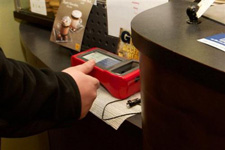When Apple released the 15-inch MacBook Pro with Retina Display last June, it started at US$2,200. When the 13-inch model arrived last October, it rang up at only $1,800. Progress, I suppose – but still a pretty penny. Now, however, Apple has dropped the prices on all Retina MBPs, and the entry level is now $1,500. With its more affordable price tag, perhaps you’re eyeing its gorgeous 2,560 x 1,600 screen. Is it worth it? Read on, as we review the 13-inch MacBook Pro with Retina Display.
For this review, we handled the entry-level (128 GB, 2.5 GHz) model. Apple recently upgraded the 256 GB model with a slightly-faster 2.6 GHz chip, but otherwise the two machines are identical.
Hardware and design
In terms of size and weight, the MacBook Pro with Retina Display (rMBP) splits the difference between the (still on the market) non-Retina MacBook Pro (MBP) and the svelte
MacBook Air.
The Retina MBP is over 20 percent thinner and 21 percent lighter than the non-Retina MBP. On the other hand, it’s 21 percent heavier and 10 percent thicker than the MacBook Air. It’s really more than 10 percent thicker than the Air, but we’re comparing the uniformly-thick Retina Pro to the tapered Air's thickest point.
The 13-inch rMBP feels great in hand, and comfortable on the lap. If you’re accustomed to using a MacBook Air, you’ll notice a difference. A bit heavier, but closer than you might expect.
Its secret is that – like the MacBook Air – it loses the old optical drive, and adds a speedy solid-state drive (SSD). So if you aren’t ready to bail on CDs and DVDs just yet, you’ll want to avoid the rMBP for now (or invest in an external DVD drive).
The Retina Pro’s design is mostly familiar. It looks a lot like a thinner version of the (non-Retina) MacBook Pro. That, however, is a good thing: same responsive (backlit) keyboard, multitouch glass trackpad, and unibody aluminum build.
One subtle difference is a thinner black bezel surrounding the screen. In fact, the laptop’s entire surface is slightly smaller than both the Air and its Pro predecessor. Shedding some excess millimeters around the keyboard and trackpad gives it a more focused appearance – and a smaller footprint in a backpack.
On its sides, the rMPB has two USB 3 ports, two Thunderbolt ports, an HDMI port, a headphone jack, and an SDXC card slot. The computer charges with a MagSafe 2 port, which uses the new T-shaped connector (the older L-shaped chargers require an adapter).
Display
So, great: it looks like a thinner MacBook Pro without an optical drive. But what about that Retina Display? That’s what you came for. All 4,096,000 pixels of it.
It doesn’t disappoint. Though the Retina MacBook Pro has fewer pixels-per-inch than the 3rd and
4th generation iPads, it doesn’t show. In fact, it looks noticeably sharper than the iPad. This is because a laptop’s screen typically sits about 8-10 inches farther away from your eyes than a tablet’s does. The rMBP’s
perceived sharpness is, right now, about as good as it gets.
On the Retina MacBook Pro, high-res photos reveal levels of detail you aren’t accustomed to seeing. Text is razor-sharp, allowing more sophisticated fonts to pop in ways that they can’t on other displays. Colors are vivid, and appear accurate under default settings.
There is one downside. Software that hasn’t been optimized for Retina Displays doesn’t look so hot. The Mac App Store’s Twitter app is a great example: it looks like garbage, with fuzzy text and pixelated images. Fortunately, most other prominent apps have shifted to Retina graphics.
Make no mistake. For all of the rMBP’s great qualities – its thinner, more compact build; its high-end performance; its great battery life – the Retina Display is the reason to buy it.
Performance
Performance-wise, the MacBook Pro with Retina Display offers similar results to its non-Retina cousin – with the added benefit of a zippy SSD.
On a technical level, the entry-level rMBP rocks a dual core 2.5 GHz (with Turbo boost to 3.1 GHz) Intel Core i5 processor, 8 GB of RAM, and integrated Intel HD Graphics 4000.
... and on an experience level? Most apps open instantly (a bounce or two in the dock at most). Processor-intensive tasks like high-res content-aware fill in Photoshop complete in a few seconds. All but the very heaviest power users will find plenty of punch here.
If you need more power, the updated 256 GB 13-inch Retina MBP (with 2.6 GHz Intel Core i5) is about 3 percent faster than this entry-level model. Apple also offers built-to-order models with a 3 GHz Intel Core i7 for the most extreme power-hungry users.
Battery life
Apple estimates that the Retina MacBook Pro’s battery will provide “up to seven hours of wireless web” use. Does it live up to the company’s promises?
My highly-unscientific testing conditions included web browsing, writing, reading, and Photoshopping high-resolution images. Brightness ranged between 50 percent and 75 percent.
Under this hodge-podge of light and heavy conditions, the rMBP lasted six and a half hours.
My use was – on average – a bit more intense than Apple’s “web use” estimate, so I’d say the seven-hour claim for web use is sound ... and perhaps even slightly understated.
Wrap-up
The MacBook Pro with Retina Display hasn’t quite dipped into the consumer laptop price range. The MacBook Air’s flag is still firmly planted in that territory.
But it is inching closer. For $300 more than the 13-inch Air, the entry-level rMBP gives you better performance, the same outstanding battery life, and – oh, yes – that utterly breathtaking display. The tradeoff is some extra weight and a slightly thicker build.
Someday soon, more affordable MacBooks (and other laptops) will sport similar displays. One rumor even suggests that the MacBook Air will join that club later this year. If you can wait a year or two, you’ll get a similar machine for cheaper. But that will always be the case with any tech product.
The MacBook Pro with Retina Display is still a bit too expensive to recommend for everyone. But if your needs lean a little toward power use – and you appreciate a cutting-edge display – then you may find it to be worth an extra $300 over a MacBook Air (or an extra $400 over the non-Retina MacBook Pro). If nothing else, your eyeballs will love you for it.




























